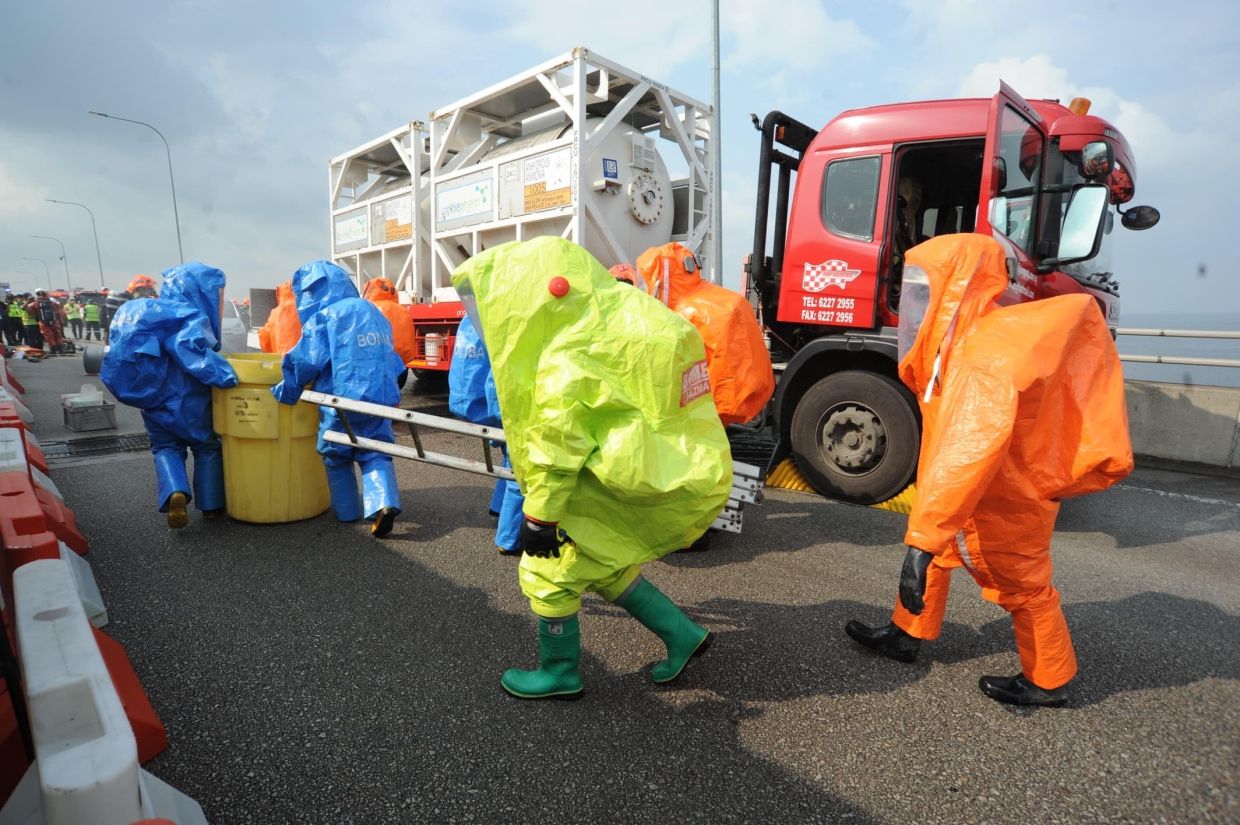
ISKANDAR PUTERI: With more than 150,000 tonnes of hazardous chemicals transported across Malaysia and Singapore through the Second Link each year, both countries tested their emergency preparedness with a large-scale chemical spill simulation on the bridge, aimed at strengthening cross-border response capabilities and protecting public safety.
The 14th Chemical Emergency Response Exercise, conducted by Singapore’s National Environment Agency (NEA) and Malaysia’s Department of Environment (DOE), involved 15 agencies and companies from both nations.
The biennial exercise is part of ongoing efforts under the Malaysia-Singapore Joint Committee on the Environment (MSJCE) to test and refine a coordinated response to potential hazardous chemical incidents on the bridge.
This year’s exercise simulated a multi-vehicle accident on the Second Link that led to the release of two dangerous substances.
According to the scenario, a truck transporting drums of concentrated sodium hydroxide lost control and collided with an ISO tanker carrying anhydrous ammonia from Singapore to the Pasir Gudang Industrial Area. A car then crashed into the wreckage, worsening the situation.
The impact caused two drums of sodium hydroxide to fall and spill, while a puncture in the tanker led to the release of about 400kg of ammonia gas into the surrounding area.
Emergency responders had to rescue “injured” drivers suffering from chemical exposure and a passenger trapped inside the car.
DOE director-general Datuk Wan Abdul Latiff Wan Jaffar said the exercise reflected the high level of preparedness and collaboration between agencies of both countries.
“I believe in the strong commitment between agencies to ensure the success of this initiative. This cooperation not only showcases our readiness to respond to unforeseen incidents but also highlights the strategic role of inter-agency collaboration,” he said after the exercise held here on Wednesday (July 23).
Wan Abdul Latiff added that within Malaysia, the DOE has strengthened coordination by delegating authority to 13 enforcement agencies under a gazette issued on July 7 this year.
“The move aims to improve the efficiency of emergency response and regulatory enforcement while upholding public confidence,” he said.
Meanwhile, NEA chief executive officer Wong Kang Jet said the success of the exercise was a testament to the strong bilateral ties between Singapore and Malaysia.
“Singapore and Malaysia continue to strengthen our cooperation through exercises such as the MSJCE chemical spill response.
“Both countries included new elements, such as different chemicals and response approaches, to ensure we remain well-prepared and well-resourced in dealing with evolving chemical incidents,” he said.
The Second Link, officially opened in 1998, is the only designated route for transporting hazardous chemicals between Malaysia and Singapore.
The restriction ensures that vehicles carrying such substances do not pass through congested urban areas like Johor Baru and Woodlands.
Common hazardous materials transported along the route include sulphuric acid, hydrochloric acid, and sodium hydroxide.
To manage the risks, the NEA and DOE have developed a Joint Emergency Response Plan (ERP) under the MSJCE.
The plan includes early notification procedures and coordinated response protocols to control and contain chemical releases in the event of an accident.
Regular joint drills are held to familiarise emergency responders with the ERP, strengthen communication lines, and test the interoperability of response systems on both sides of the border.
Authorities said that the exercise served not only to enhance operational readiness but also to raise public awareness about safety protocols related to hazardous materials transport.
“This is about more than just agencies being ready but it is about making sure the public is protected, and that we have the tools, knowledge, and coordination in place to act swiftly if something goes wrong,” said a joint statement from the organising agencies.
The next joint emergency drill is scheduled for 2027.






